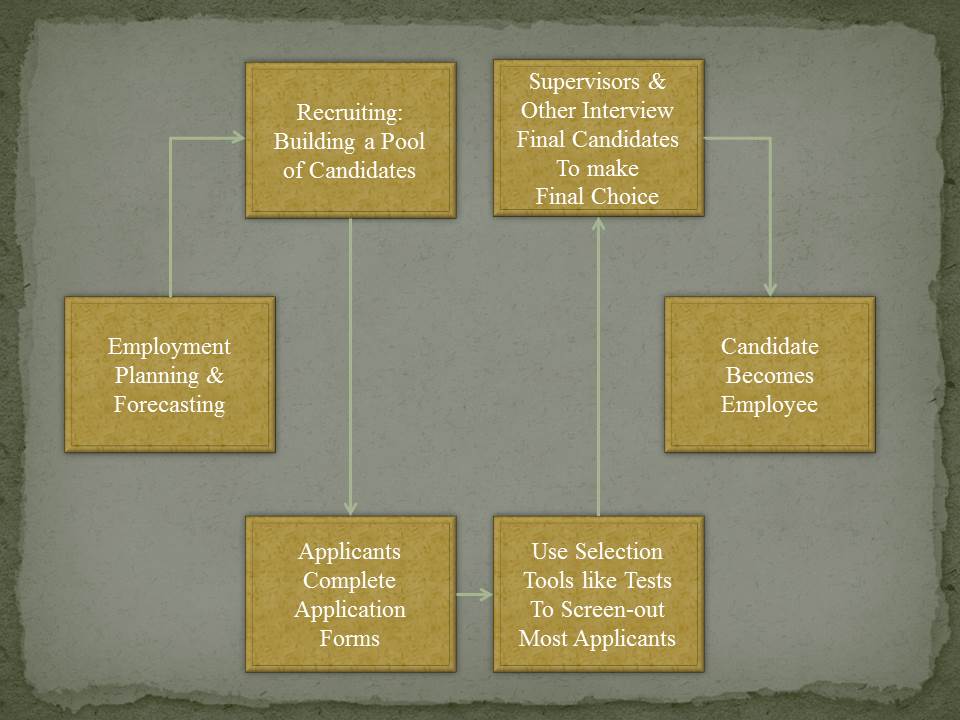The Recruitment and Selection Process
- Decide which positions have to fill through HR planning and forecasting.
- Build a pool of candidates for these positions by recruiting internal or external candidates.
- Have candidates complete application forms and perhaps undergo an initial screening interview.
- Use suitable selection techniques like tests, background investigations, and physical exams to identify viable candidates.
- Decide to make an offer to whom, by having the supervisor and perhaps others on the team interview the candidates.
Planning
- Employment or HR Planning
- The process of deciding which positions will have to fill and how to fill.
- Succession Planning
- The process of deciding how to fill the most important executive jobs in the company.
Forecast
- Overall personnel needs
- The supply of inside candidates
- The supply of outside candidates
Forecasting Human Needs
- Trend Analysis
- The study of a company’s past employment needs over a period of years to predict future requirement.
- Ratio Analysis
- A forecasting technique for determining future staff needs by using ratios between a causal factor and the number of employees required.
- Scatter Plot
- Usage of a graphical method to help to identify the relationship between two variables.
Forecasting the Supply of Inside Candidates
- Qualifications Inventories
- Manual or computerized records listing such as employees’ education, career and development interests, languages, special skills, and so on, to be used in selecting inside candidates for promotion.
Manual Systems and Replacement Charts
- Personnel Replacement Charts
- Company records showing present performance and promote-ability of inside candidates for the most important positions.
- Position Replacement Card
- A card prepared for each position to show possible replacement candidates with their qualifications.
Computerized Information Systems
- Human Resource Information System (HRIS)
- Computerized inventory of information that can be accessed to determine background, experience, and skills of employees that may include:
- Formal education
- Work experience codes
- Product or service knowledge
- Industry experience
- Computerized inventory of information that can be accessed to determine background, experience, and skills of employees that may include:
Forecasting the Supply of Outside Candidates
- Factors impacting the supply of outside candidates include:
- General Economic Conditions (GEC)
- Expected Unemployment Rate (EUER)
- Sources of information
- Periodic Forecasts in Business Publications
- Online Economic Projections, such as
- U.S. Congressional Budget Office (CBO)
- Bureau of Labor Statistics (BLS)
- U.S. Department of Labor: O*Net
- Other Federal Agencies
Effective Recruiting Factors
- External Factors affecting Recruiting:
- Alarming under-supply of workers
- Reduction of the trend in outsourcing of jobs
- Increasingly fewer “qualified” candidates
- Internal Factors affecting Recruiting:
- The consistency of the firm’s recruitment efforts with its strategic goals
- The available resources, types of jobs to be recruited and choice of recruiting methods
- Non-recruitment HR issues and policies
- Line and staff coordination and cooperation
- Advantages of Centralizing Recruitment
- Strengthens Employment Brand
- Ease in applying strategic principles
- Reduces duplication of HR activities
- Reduces the cost of new HR technologies
- Builds teams of HR experts
- Provides for better measurement of HR performance
- Allows for the sharing of applicant pools
Measuring Recruiting Effectiveness
- What and How to Measure
- How many qualified applicants were attracted to each recruitment source?
- Assessing both the quantity and the quality of the applicants produced by a source.
- How many qualified applicants were attracted to each recruitment source?
- High-Performance Recruiting
- Applying best-practices management techniques to recruit.
- Using a benchmarks-oriented approach to analyze and measure the effectiveness of recruiting efforts such as employee referrals.
- Applying best-practices management techniques to recruit.
Also Read Human Resource Management – Part 1
Human Resource Management – Part 2
Human Resource Management – Part 3
Human Resource Management – Part 4
